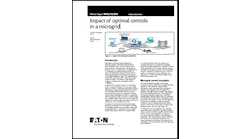Eric Dupont of PowerSecure discusses an approach called Microgrid 360 which follows a series of high standards designed to optimize each microgrid for its intended application.
Eric Dupont, executive vice president and chief commercial officer, PowerSecure
Microgrids are unique, with customer-specific customization occurring on many levels. They must be sized and connected appropriately to handle a certain amount of base load under normal operations, as well as all mission-critical loads in island mode. In addition, there are many ways to power a microgrid, so the choice must adhere to the customer’s clean energy goals and make economic sense.
These unique solutions range from very basic to complex microgrids. Once the system is up and running, testing, monitoring and performance management comes with as many nuances as there are microgrid providers. Given this high level of customization, can a universal gold standard emerge for microgrids?
A long list of clear standards that all microgrids must adhere to exists, for example:
- Federal, state and local emissions requirements
- Utility interconnection requirements
- Siting limitations
- Local permitting
- Customer requirements.
In many ways, these requirements form the gold standard for how microgrids are developed consistently. These standards, however, only cover a limited portion of the design and management of a microgrid.
Achieving a microgrid gold standard is not in the configuration of the end solution, but rather in the process of designing, delivering and optimizing it. Even though each microgrid is unique, the same gold standard of rigor can be applied to its creation and on-going management. At PowerSecure, we call this process the Microgrid 360.
After more than 2,000 microgrid installations over 18 years, we see microgrids as long-term living assets that are performance optimized over their life cycle. Microgrids should be developed so they can be reliably operated for a very long time, and constantly performance managed to maximize economic value, even as the customer’s energy usage trends evolve and market pricing shifts.
The typical definition of a microgrid life cycle only spans the lifetime of a single configuration, but life cycle should be treated systematically at a corporate level. It relies on system-wide feedback, where data points and lessons learned from past installations are fed into the next microgrid, ensuring best-in-class performance from day one. This 360-degree view and expertise is what we call Microgrid 360, which allows for superior performing microgrids and a design that can save you money.
The Microgrid 360 approach can be broken down into three processes.
- First, end-to-end expertise is brought to customers, from the concept and design of a microgrid, through its development and implementation, to on-going performance management. Product innovators, engineers, commissioning and energy efficiency experts get involved at the right time in the project through a vertically integrated organization. This results in optimized time to successful implementation.
- Second, the right technologies should be deployed from the start, and future upgrades facilitated by technology experts.
- Third, product and component choices should be based on lifetime performance and robust quality assurance processes. It’s best when you can use empirical evidence collected from many microgrids on a daily basis to feed back into the design process.
Monitoring microgrids 24/7/365 shows what products and components really stand the test of time based on how they have been used before. Alongside this, it’s important to conduct extensive quality control procedures, and have the ability to simulate the sequence of operations and performance optimization environment on the actual microgrid assets.
Eric Dupont is the executive vice president and chief commercial officer of PowerSecure. To learn more about the PowerSecure Microgrid 360 process download our white paper or sign up for a Microgrid 360 tour.







